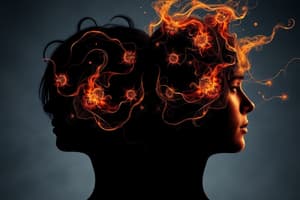Podcast
Questions and Answers
What factors determine the desire to reduce cognitive dissonance according to Festinger?
What factors determine the desire to reduce cognitive dissonance according to Festinger?
- The emotion connected to the dissonance
- The potential financial gain from changing behavior
- The degree of support from others
- The importance of the elements and the perceived control over them (correct)
Which moderating variable is likely to show a strong relationship to behavior according to the content?
Which moderating variable is likely to show a strong relationship to behavior according to the content?
- The frequency of social interactions
- The importance of the attitude reflecting fundamental values (correct)
- General attitudes towards life events
- Transitory emotions experienced during tasks
Under which circumstance might discrepancies between attitudes and behavior commonly occur?
Under which circumstance might discrepancies between attitudes and behavior commonly occur?
- When personal beliefs are in harmony with group values
- When individuals have high self-efficacy
- When external rewards are minimized
- When there are strong social pressures to conform (correct)
What is the relationship between specific attitudes and behavior as described in the text?
What is the relationship between specific attitudes and behavior as described in the text?
What role does accessibility of an attitude play in behavior prediction?
What role does accessibility of an attitude play in behavior prediction?
What is cognitive dissonance?
What is cognitive dissonance?
Which of the following strategies is NOT typically used to resolve cognitive dissonance?
Which of the following strategies is NOT typically used to resolve cognitive dissonance?
How might social pressures influence attitude change?
How might social pressures influence attitude change?
Which of the following describes rationalization in behavior?
Which of the following describes rationalization in behavior?
What is implied by the predictive value of attitudes?
What is implied by the predictive value of attitudes?
Flashcards are hidden until you start studying
Study Notes
Cognitive Dissonance Theory
- Cognitive dissonance occurs when an individual perceives inconsistency between attitudes or between behavior and attitudes.
- Festinger proposed that individuals seek to reduce dissonance for comfort.
- The degree of motivation to reduce dissonance depends on the importance of creating elements, perceived control over them, and the rewards involved.
Attitudes and Behavior Relationship
- Research suggests that attitudes can predict behavior.
- Important attitudes correlate strongly with behavior, reflecting personal values and self-interest.
- Specific attitudes predict specific behaviors, unlike general attitudes predicting general behaviors.
Moderating Variables in Attitudes
- Importance of the attitude influences its correlation with behavior.
- Attitudes that are easily accessible from memory are more likely to predict behavior effectively.
- Social pressures can create discrepancies between attitudes and behaviors in organizational contexts.
- Direct personal experience with an attitude strengthens its predictive power regarding behavior.
Components of Attitude
- Attitudes consist of three components:
- Cognitive: Beliefs and opinions.
- Affective: Emotional responses.
- Behavioral: Intentions to act in certain ways.
Job Satisfaction and Related Concepts
- Job satisfaction is a positive feeling derived from the evaluation of job characteristics.
- Job involvement refers to the degree of identification with a job and its significance to self-worth.
- Psychological empowerment relates to an employee's belief in their impact on their work.
- Organizational commitment reflects the employee's alignment with organizational goals and desire to stay.
- Employee engagement includes the individual's involvement and enthusiasm for their work.
Causes and Outcomes of Job Satisfaction
- Main causes of job satisfaction include job conditions, personality, pay, and corporate social responsibility.
- Positive job satisfaction leads to higher job performance, organizational citizenship behavior, customer satisfaction, and life satisfaction.
Impact of Job Dissatisfaction
- Dissatisfaction can manifest through:
- Exit: Behavior directed at leaving the organization.
- Voice: Constructive feedback and attempts to improve conditions.
- Loyalty: Optimistic waiting for conditions to improve while supporting the organization.
- Neglect: Passive allowance of conditions to worsen, demonstrated through absenteeism or reduced effort.
Studying That Suits You
Use AI to generate personalized quizzes and flashcards to suit your learning preferences.




